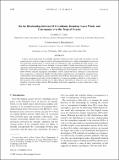On the Relationship between SST Gradients, Boundary Layer Winds, and Convergence over the Tropical Oceans
Author(s)
Back, Larissa E.; Bretherton, Christopher S.
DownloadBack-2009-On the Relationship.pdf (1.856Mb)
PUBLISHER_POLICY
Publisher Policy
Article is made available in accordance with the publisher's policy and may be subject to US copyright law. Please refer to the publisher's site for terms of use.
Terms of use
Metadata
Show full item recordAbstract
A linear mixed layer model that skillfully reproduces observed surface winds and convergence over the tropical oceans is used to examine the relative influence of boundary layer and free-tropospheric processes on the distribution of climatological surface winds and convergence. The semiempirical model assumes a subcloud-layer momentum force balance between pressure gradients, Coriolis acceleration, linearized friction, and downward momentum mixing, and it utilizes boundary conditions from the 40-yr ECMWF Re-Analysis (ERA-40). Observed pressure gradients are linearly decomposed into boundary layer (defined as the region below 850 hPa) and free-tropospheric components, and the surface winds and convergence associated with these components are computed. Results show that surface zonal winds are predominantly associated with a combination of free-tropospheric pressure gradients and downward momentum mixing, whereas the distribution of convergence is primarily due to boundary layer temperature gradients, which are closely related to SST gradients. The authors conclude that the climatological distribution of boundary layer convergence is primarily a function of the pattern of SST gradients and is better regarded as a cause rather than a consequence of deep convection.
Date issued
2009-08Department
Massachusetts Institute of Technology. Department of Earth, Atmospheric, and Planetary SciencesJournal
Journal of Climate
Publisher
American Meteorological Society
Citation
Back, Larissa E., and Christopher S. Bretherton. “On the Relationship Between SST Gradients, Boundary Layer Winds, and Convergence over the Tropical Oceans.” Journal of Climate 22.15 (2009) : 4182-4196.© 2009 American Meteorological Society.
Version: Final published version
ISSN
0894-8755
1520-0442